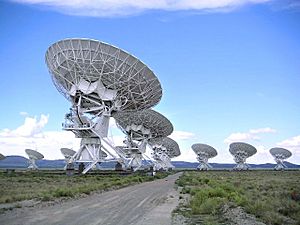Radio astronomy facts for kids
Radio astronomy is a special way of studying space. It uses giant antennas to "listen" to objects in the universe. These antennas pick up radio waves that come from stars, galaxies, and other things far away. It's like having a super-sensitive radio receiver that can hear whispers from the cosmos!
Scientists use radio astronomy to learn about things we can't see with regular telescopes. This is because many space objects give off radio waves, not just visible light.
Contents
How Radio Astronomy Began
The idea of listening to space with radio waves started a long time ago.
First Discoveries
In the 1930s, a scientist named Karl Guthe Jansky made an amazing discovery. He found radio waves coming from the center of our own galaxy, the Milky Way. This was the very first time anyone had detected radio signals from space!
After Jansky's discovery, other scientists started looking for more radio signals. They found that many different things in space give off radio waves. These include stars and galaxies. They also found completely new types of objects.
New Space Objects
Radio astronomy helped us discover exciting new objects like:
- Radio galaxies: These are galaxies that shine very brightly in radio waves.
- Quasars: These are super bright centers of distant galaxies. They are powered by huge black holes.
- Pulsars: These are rapidly spinning stars that send out regular pulses of radio waves. It's like a lighthouse in space!
- Masers: These are natural sources of very strong radio waves. They are similar to lasers, but they use radio waves instead of light.
The Big Bang Clue
One of the most important discoveries made with radio astronomy was the cosmic microwave background radiation. This is a faint glow of radio waves that fills the entire universe. It's like an echo from the very beginning of the universe. This discovery gave strong evidence for the Big Bang theory, which explains how our universe started.
How Radio Telescopes Work
Radio astronomy uses special tools called radio telescopes. These are very different from the telescopes you might imagine.
Giant Antennas
Radio telescopes are usually large antennas shaped like dishes. They collect the faint radio waves coming from space. The bigger the dish, the more radio waves it can collect. This helps scientists "see" fainter and more distant objects.
Working Together
Sometimes, a single radio telescope isn't enough. To get a clearer picture of space, scientists link many radio telescopes together. This method is called interferometry.
When many telescopes work together, they act like one giant telescope. The bigger the distance between the telescopes, the more detailed the image they can create. This allows radio astronomers to see very fine details in distant objects. It's like having super-sharp vision for the universe!
Images for kids
-
Grote Reber's Antenna at Wheaton, Illinois, world's first parabolic radio telescope
-
Chart on which Jocelyn Bell Burnell first recognised evidence of a pulsar, in 1967 (exhibited at Cambridge University Library)
-
The Atacama Large Millimeter Array (ALMA), many antennas linked together in a radio interferometer
-
An optical image of the galaxy M87 (HST), a radio image of same galaxy using Interferometry (Very Large Array – VLA), and an image of the center section (VLBA) using a Very Long Baseline Array (Global VLBI) consisting of antennas in the US, Germany, Italy, Finland, Sweden and Spain. The jet of particles is suspected to be powered by a black hole in the center of the galaxy.
-
Antenna 70 m of the Goldstone Deep Space Communications Complex, California
-
Antenna 110m of the Green Bank radio telescope, USA
See also
 In Spanish: Radioastronomía para niños
In Spanish: Radioastronomía para niños









